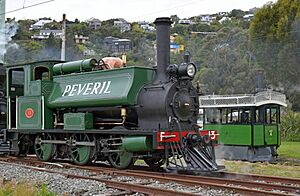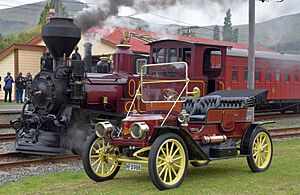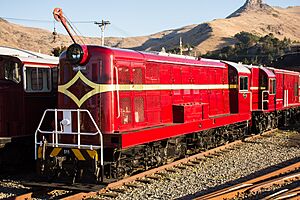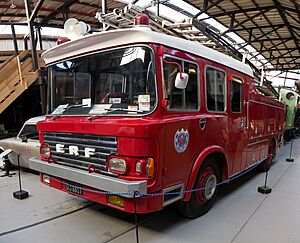Ferrymead Heritage Park facts for kids
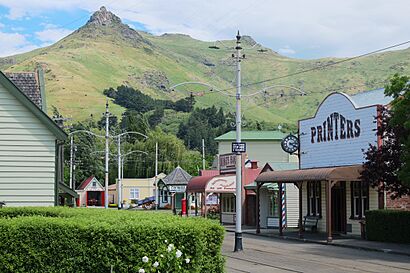
The main street of the replica historic village, with Te Tihi-o-Kahukura / Castle Rock visible in the background
|
|
| Former name | Ferrymead Historic Park, Museum of Science and Technology |
|---|---|
| Location | Ferrymead, Christchurch, New Zealand |
| Coordinates | 43°34′02″S 172°42′08″E / 43.567286111111°S 172.7022°E |
| Website | www |
Ferrymead Heritage Park is an outdoor museum in Christchurch, New Zealand. It is a fun place to learn about history.
The park started in 1964. It was first called the Museum of Science and Technology. Later, it became Ferrymead Historic Park. Groups who loved old things needed a place to keep and show them off. The park is in the Heathcote Valley. This is where New Zealand's first public railway once ran. Volunteers mostly run the museum, and it is open to everyone.
Explore the Historic Village
Ferrymead looks like an old village from the early 1900s. This time is known as the Edwardian era. Some buildings are copies, but others are real historic buildings moved here. You can see a church, a theatre, and old houses. There is also a prison and a special meeting hall.
Many buildings have old-fashioned decorations inside. Some houses even have working kitchens. The village also has a train station. This station is for the short railway track used by the park's trains. A main street runs through the village. It has tram tracks that go in a loop.
Interactive Experiences
Different history groups show their collections around the park. Most exhibits are old machines and vehicles that you can look at. On special event days, usually once a month, you can have a more interactive experience.
You can ride trams or trains. You might see how old printing presses worked. You can also try out old telephone equipment. There is even a working model railway. Park volunteers often dress in old clothes. This helps you feel like you've stepped back in time!
The park has some very special old vehicles. The oldest working steam train in New Zealand is here. It is called "Peveril" and is an NZR F Class F13 Peveril. The park also has the only working Kitson and Company steam tram in the world. It is named No. 7 "Kitty". Another special tram is the bright green Christchurch No. 1 tram. It was built in New York in 1905. It was one of the first electric trams in Christchurch and still runs at the park.
Park History
New Zealand's First Railway
In the early days of Christchurch, Ferrymead was an important place. People crossed the Heathcote River here on their way between Lyttelton and Christchurch. For about 17 years, starting in 1850, Ferrymead was very busy. It was also the site of New Zealand's very first railway.
The railway opened in 1863 for steam trains. It connected the Bridle Path to the wharves at the Heathcote Estuary. But when the Lyttelton Rail Tunnel opened around 1867, the Ferrymead railway was not needed as much. It became New Zealand's first railway to open and also the first to close. The area then became a swampy, empty space.
Starting the Museum
In the mid-1960s, people wanted to create a museum. They wanted to show "science and industry." They especially wanted to save old trains. At first, they thought about locations like Hornby or Prebbleton. But these plans did not work out.
Finally, the museum group started setting up buildings in Hornby in September 1964. The museum planned to open in March 1966.
Moving to Ferrymead
The idea of using the Ferrymead site came up in October 1964. But Hornby seemed easier at first. However, after only a few months, the museum needed a bigger space. Many people wanted to donate their old equipment for exhibits.
Also, the Tramway Historical Society wanted to build a tram track. Ferrymead had enough space for this. The Heathcote County Council gave the Ferrymead site to the museum. By October 1966, work was busy turning the site into a heritage museum. Tracks were being laid by April 1967.
Growing and Challenges
Over the years, more history groups joined the park. It grew steadily. However, the park often had money problems. It relied a lot on fundraising and volunteers. Volunteers gave their time and skills to keep the exhibits running.
The park was meant to be a tourist attraction. It hoped to earn money from ticket sales. But tourists in Christchurch were not very interested in visiting. Also, some groups at the park just wanted a place for their clubs and equipment. This meant exhibits were not always open, which made it harder for visitors.
In 1995, the park faced serious money issues. The trust that ran the park asked the Christchurch City Council for help. In 1996, a deal was made. The council bought a large part of the park land. Then, they gave back about 8 hectares (20 acres) to the park trust. This helped the park pay off its debts. The council also took over managing the park. This deal helped Ferrymead Heritage Park stay open.
Ferrymead Today
As of 2024[update] the park is run by the Ferrymead Trust. Day-to-day work is handled by Ferrymead Park Ltd. The trust also works with 15 non-profit groups at the park. Since 2015, the park has received money from the city council each year. This helps cover some of its yearly costs.
In 2024, the park again faced money problems. This was partly because fewer people visited after the COVID-19 pandemic. The Christchurch City Council gave the park a grant of NZ$400,000 to help it keep running. The park's director, Jarrod Coburn, said the park needed to become more than just a place for hobbies.
A small disagreement happened in mid-2024. There was a plan to remove an old brick oven in the park's bakery. The oven was built in the 1970s and had not been used since the 2011 Christchurch earthquake. Park management said the oven was damaged and had asbestos. But groups at the park did not want it removed. They said it would be wrong to destroy it. The plans to remove the oven were put on hold.
Park Societies
Many non-profit groups have joined the park over the years. They help keep history alive.
Canterbury Railway Society
The Canterbury Railway Society was one of the first groups at the park. They run the 3 ft 6 in (1,067 mm) narrow gauge railway at Ferrymead. They own, fix, and care for old trains and railway cars. This society runs the trains for visitors to ride on special open days.
Diesel Traction Group
The Diesel Traction Group owns and cares for several English Electric diesel-electric trains. These trains were once used by the New Zealand Railways Department in the mid-1900s.
Tramway Historical Society
The Tramway Historical Society fixes and operates trams at the park. On open days, these old trams take short rides on the standard gauge Ferrymead Tramway. They travel between the historic village and the tram maintenance sheds. This society also helps maintain the trams that run in central Christchurch.
Other Societies
The Fire Services Historical Society has the largest collection of old fire engines in the southern hemisphere at the park.
The Ferrymead Post and Telegraph Historical Society cares for old communication equipment. This includes items from New Zealand's postal, telegraphy, and telephone services. They have old manual switchboards and automatic phone systems. This equipment still works and can be used to make calls between rooms.
The Radio Preservation Society runs a radio station at Ferrymead. They broadcast music on 1413 kHz AM on weekends. The station's old call sign was 3XP. Besides a working radio studio, the society has a museum of old radio equipment for visitors.
Other smaller history groups also operate from the park, such as:
- Canterbury Centre for Historic Photography & Film Inc.
- Ferrymead Aeronautical Society Inc.
- Ferrymead Printing Society Inc.
- Friends of Ferrymead Fraternity Inc.
- Garden City Model Railroad Club Inc.
- Heathcote Studios Theatrical Society Inc.
- Lions Club of Ferrymead Inc.
- Society of Rural History Inc.
Park Location
Ferrymead Heritage Park is in the lower Heathcote Valley. To the north, the Ōpāwaho / Heathcote River bends before it flows into the estuary. The Main South Line railway passes the park to the south-west. This connects the park to New Zealand's main railway system. The Christchurch City Council owns much of the land in this area, including the park itself.
Because it is low-lying and near the sea, the area is part of a flood management zone. Some unused land around the park has been sold or leased for other fun businesses. These include a golf club and a paintball field. In 2024, a large area of unused land was set aside. It will be restored into a wetland as part of the Ferrymead Regional Park.
An area near the park was once used as a landfill. A raised spot called "Woods Hill" was created by dumping and compacting rubbish there for many years. In 2020, this landfill was identified as a possible risk. It could release harmful materials into the estuary.
See also


